Deir ez-Zor was a beautiful city on the shores of the Euphrates River, surrounded by a fertile and prosperous farming area. It was also a tourist destination with riverbank restaurants, hotels, and a hub for trans-desert travels.
The Armenian Genocide Martyrs’ Memorial Church, completed in 1990, was not only a church, but also a museum, monument, archive centre, and exhibition. Every year in April thousands of Armenian pilgrims from all over the world descended onto Deir ez-Zor to commemorate the genocide victims in the presence of their religious leaders. In September 2014 the Church and all attached buildings were destroyed by the terrorists of IS (Islamic State).

The beautiful suspension bridge across the Euphrates was another famous tourist attraction, it is destroyed now as well.
An epic battle
In 2013 a coalition of various Islamic militias, among them Jabhat al-Nusra and Ahrar al-Sham, captured most of Deir ez-Zor province and part of the capital city (in Syria, a province and its capital always have the same name), but soon infighting between the militias started and in April 2014 IS launched an offensive against their fellow jihadists which resulted in the total defeat of the other groups. In July IS controlled the whole Deir ez-Zor province with the exception of Deir ez-Zor city.

After closing all roads and cutting off power lines and communication cables to the city enclave, IS in December 2014 launched an offensive against the Deir ez-Zor military air base. During three days of fighting, some 200 Islamic fighters and 43 Syrian soldiers were killed. IS could penetrate the air base and seize a strategic mountain plus two nearby villages, but the Syrian army eventually repelled the offensive.
Several other attacks on the enclave followed and failed, yet in January 2016 a massive attack which included six SVBIEDs (suicide-vehicle-born-explosive-devices) overran the Baghiliya and Ayyash neighborhoods of the city. Some 400 civilians were captured and mostly executed (beheaded).
IS then assaulted the Sina’ah district, the industrial zone, the Thayyem Oil Fields and the strategic Jebel (mountain) Tharda. Heavy Russian air-strikes helped the troops stationed on the mountain to fend off the militants.
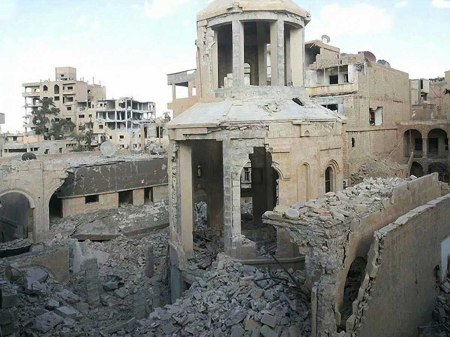
In September 2016, US and allied fighter aircrafts attacked Syrian positions on Jebel Tharda, killing over 80 soldiers and wounding 110 more in a two hour long raid. IS launched a broad offensive immediately after the bombing and was finally able to take Jebel Tharda and subsequently the whole mountainous areas overlooking the airport. This made the air base unusable for Syrian and Russian aircrafts, as the runway was exposed to IS fire.
Considering all known facts, the repeated averments and declarations of US-military spokespersons that the air raids were a mistake are implausible and unconvincing, the only explanation which makes sense is that the US-coalition jets were sent to help IS overrun the enclave.
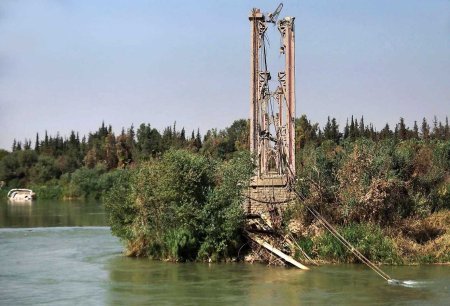
In January 2017, IS was able to take the cemetery area and cut the road between Deir ez-Zor airport and the city, leaving the enclave split in two.
After that IS conducted waves of attacks on a daily basis, which were ultimately all repelled. Most of the attack were directed at the Panorama roundabout, the 137th regiment military base, and two hills at the southern entrance to the city.
Suffering and heroism
The three year long siege of Deir Ez-Zor by the Islamic State terrorists has ended now. After the victory in Aleppo this is another pivotal moment in the Syrian war and it will energize the defenders of Syria and demoralize the attacking jihadists.
The legendary commander of the “Tiger Forces” General Suheil al-Hassan personally led the offensive to relief Deir ez-Zor. He and his men were also responsible for breaking the siege of the Kuweires airport in November 2015. Kuweires is another epic tale of suffering and endurance, as only 300 of the 1,100 defenders survived.
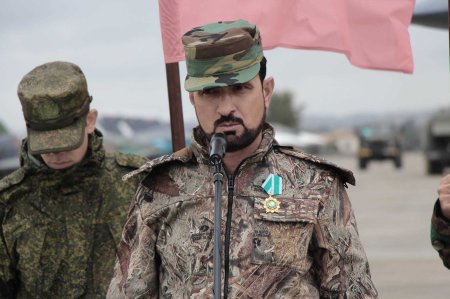
During the siege of Deir ez-Zor the population of the city has decreased from 210,000 to 120,000, as many civilians have been evacuated via helicopter and an untold number of both soldiers and civilians died. The siege resulted in widespread malnutrition and starvation, though since 2015 Russia and the UN World Food Program have conducted airdrops of food and other humanitarian supplies to the besieged city. There is no electricity, a few power generators are used to pump water from wells and the river, but the water can be supplied only twice a week and it is untreated because IS has destroyed all treatment facilities with mortars and rockets.
The people of DeZ have suffered beyond comprehension, facing certain death at the hands of the Islamic terrorists in case of a defeat. The ones that stubbornly remained in the enclave are all ardent supporters of the Baath government and none of them would have been spared the wrath of IS.
It will never be known how many people parished during the siege, but the death toll includes for sure more than 2,000 Syrian soldiers and about 6,000 to 8,000 IS-fighters. In the war against IS, Deir ez-Zor may in fact be even more important that the Kurdish city Kobane, since it was the battlefield wich proved most costly to the terror organization. Many jihadists died in a massive minefield to the east of the city and the desert around the enclave is littered with corpses, left rotting in the blistering sun because it would be suicidal to retrieve them as snipers and gunners on both sides look for targets.
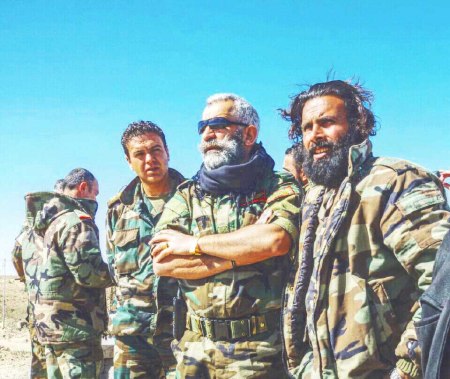
Deir Ez-Zor was defended by the elite Republican Guards of the 104th Airborne Brigade, which are led by the highly respected and famed General Issam Zahreddine. He took over the garrison after General Jameh Jameh was killed by a sniper. In November 2013, while commanding his forces in al-Rashdiya district, Zahreddine was wounded in the leg by a bullet. Zahreddine is a Druze, his son Yarob is also in the city, fighting alongside him. General Zahreddine is also on a EU sanctions list, a batch of honor he certainly will be proud of and enjoy.
New troops were brought in and wounded soldiers evacuated via helicopter, but this was always dangerous and could only be done in the night as IS tried to hit the helicopters with all available means. One Mi-8 helicopter was lost and a few others barely escaped attacks by guided missiles.
No words can describe the steadfastness and heroism of the garrison. This is, together with the victory in Aleppo, the most significant and iconic battle victory through the entire Syrian war. Books will be written and movies directed, the surviving defenders in the city enclave will be honored, praised, saluted, and never forgotten. They have made history.
How it happened
The biggest town between Palmyra and Deir-ez-Zor is al-Suknah, and the fight for it was bitter and bloody. The town could only be taken after it was approached from several axis, it is a wasteland now and sappers are still working to defuse mines and booby traps.
While approaching al-Suknah from Palmyra and al-Resafa, the Syrian forces cut off IS militants in two huge but sparsely populated pockets, consisting mainly of desert area with small isolated villages. The eastern one is cleared now, the western one is constantly shrinking and Ukayribat, the main town in this pocket, has just been liberated in a fierce battle after several failed attempts and setbacks due to IS suicide attacks. At the moment there is only a small area near al-Salamiya still under Islamist control.
There was also the option to reach Deir-ez-Zor in a push along the Euphrates River via al-Maadan, but IS recaptured a string of villages on the river in a devastating counteroffensive, killing more than 100 Syrian troops. The transfer of IS forces to al-Maadan though left the area between al-Suknah and Deir-ez-Zor exposed.

The terrain after al-Suknah is rather flat with the only exception of Jebel Bisri west of the city, so advancing from there was much easier than from Palmyra to Suknah. Jebel Bisri and the al-Kharata oilfield between Bisri and Deir-ez-Zor were captured surprisingly fast, indicating that IS-defense lines had collapsed.
The Syrian army (including Tiger Forces and Shaitat fighters) advanced on two fronts east of al-Suknah (Ayyash and Hrybsheh near Kabajeb) to meet at al-Shulah. They dismantled an IS communications network (sixth communication tower) near al-Shula and detained a large group of IS-members. The IS supply lines to the Deir ez-Zor front were largely cut.
A small special unit infiltrated under heavy air support IS positions at brigade 137 on the western edge of the city from the rear which allowed the defenders inside to retake several positions, while the army, Hezbollah, Republican guard, Tiger forces, Palestinian Galilee Forces, and 4th Division units, who were just days ago sent from Damascus, tried to establish a corridor to the Panorama Roundabout.
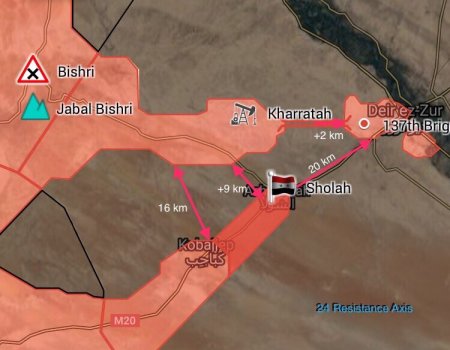
The effort was immens on both sides. IS hastily had sent reinforcements from al-Maadan back to the western and southern entrance of the city and also mobilized every single one of their fighters positioned near the enclave. They made a suicidal last stand, outnumbered, outsmarted, and an easy target for jets and artillery in the open desert. It would have made more sense to withdraw and disperse in the desert, but they chose getting slaughtered on the frontline.
IS tried to stop government troops advances by sending over a dozen of SVBIEDs against Syrian troops. Most of them were destroyed by the Russian Air Force, some were destroyed by anti-tank missiles. A Russian frigate in the Mediterranean Sea fired Kalibr cruise missiles at strategic IS targets, destroying a communications and command centre, ammunition depots, and an armored vehicle repair shop. Two Russian soldiers were killed, when their vehicle column was hit. IS also counter attacked on the northern flank of the Tiger Forces offensive in the vicinity of the al-Kharata oilfield.
In the Shoula area IS managed to get behind Syrian forces and to ambush an army unit, however, the attack was repelled eventually. As a result of the ambush, the army had to retreat temporarily.
Meanwhile soldiers in the enclave were franticly working to open loopholes in the minefields to enable safe passage of arriving units and of the trucks full with food and medicine which they brought with them.
The air base was approached via the Al Tayyim Oil Well. This is a strategic important point wich allows the linking of the air base with the city and the recapture of the cemetery.
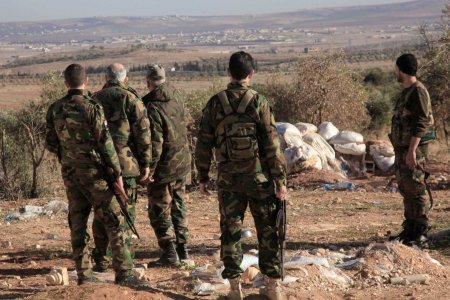
When finally a dozen Syrian tanks plus support vehicles entered the Brigade 137 base, it was clear that the siege had been broken. The new corridor is wide enough to allow a safe transfer of troops and supplies.
Already before this arrival the army had raised the Flag of the Syrian Arab Republic in the Armenian Cemetery at the southern entrance of Deir ez-Zor, only five kilometer from the Panorama Roundabout, and Governor Mohammed Ibrahim Samra had declared the end of the siege. The residents of Deir ez-Zor are celebrating in the streets since three days despite mortars and artillery shells from IS still raining down onto them.
Fighting is not over yet and it will take some days till the IS holdouts in the cemetery area and in the northern parts of the city have been eliminated.
Final notes
This development is so significant that not even Western mainstream media can ignore it and first reports appeared already on Reuters, AP, and the British Independent. The Syrian broadcaster SANA has started a life stream on YouTube which is watched by thousands, the Twitter and Facebook scene is buzzing with news, questions, and comments. This is big news, this is a game changer, this is a big moral boost for all Syrians who support the secular state, no matter how Western propagandists will try to spin it.
The relief of the siege has also geopolitical consequences, as it opens the way to Al-Qaim and Al-Bukamal on the Iraqi border. Palmyra, Sukhna, Deir ez-Zor, al-Bukamal are important links in the direct land route from Iran to Lebanon, which could become the backbone of the “Shia Crescent”.
The US-coalition pressures the Kurdish led SDF forces to reach al-Bukamal via the Khabur route, following the Khabur River from southern Hasakah province into Deir ez-Zor province. At al-Busayrah, where the Khabur meets the Euphrates, SDF forces would march south along the eastern bank of the Euphrates toward Mayadin and from there to al-Bukamal. As long as the SDF is fighting in Raqqa such an offensive is not likely, but after the fall of Raqqa there could be a tough race between the Syrian army and the SDF towards al-Bukamal.
One last word:
This is war, and though the inhabitants of Deir ez-Zor and with them all Syrians are more than entitled to celebrate this victory, an uninvolved observer has to remain sober and reflective. Whatever helps to avoid death and destruction has to be done, and the constant reconciliation and appeasement efforts of the Assad government and Russia are the right way, even if crimes remain unpunished and perpetrators evade justice.
It may not be possible to integrate the most severe cases, the psychopathic, unrepentant, remorseless, unalterable criminals back into society. They will have to be neutralized somehow. Other than that though, everyone deserves another chance to join humankind.
Related:
https://mato48.com/2014/08/07/the-tragedy-of-deir-ez-zor/
https://mato48.com/2016/09/18/evil-has-a-name/
Update
Another map:
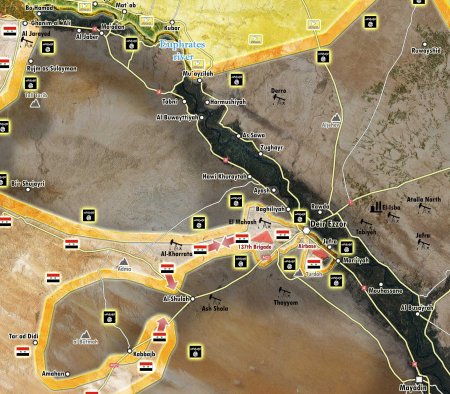
The Armenian Genocide Martyrs’ Memorial Church, completed in 1990, was not only a church, but also a museum, monument, archive centre, and exhibition. Every year in April thousands of Armenian pilgrims from all over the world descended onto Deir ez-Zor to commemorate the genocide victims in the presence of their religious leaders. In September 2014 the Church and all attached buildings were destroyed by the terrorists of IS (Islamic State).

The beautiful suspension bridge across the Euphrates was another famous tourist attraction, it is destroyed now as well.
An epic battle
In 2013 a coalition of various Islamic militias, among them Jabhat al-Nusra and Ahrar al-Sham, captured most of Deir ez-Zor province and part of the capital city (in Syria, a province and its capital always have the same name), but soon infighting between the militias started and in April 2014 IS launched an offensive against their fellow jihadists which resulted in the total defeat of the other groups. In July IS controlled the whole Deir ez-Zor province with the exception of Deir ez-Zor city.

After closing all roads and cutting off power lines and communication cables to the city enclave, IS in December 2014 launched an offensive against the Deir ez-Zor military air base. During three days of fighting, some 200 Islamic fighters and 43 Syrian soldiers were killed. IS could penetrate the air base and seize a strategic mountain plus two nearby villages, but the Syrian army eventually repelled the offensive.
Several other attacks on the enclave followed and failed, yet in January 2016 a massive attack which included six SVBIEDs (suicide-vehicle-born-explosive-devices) overran the Baghiliya and Ayyash neighborhoods of the city. Some 400 civilians were captured and mostly executed (beheaded).
IS then assaulted the Sina’ah district, the industrial zone, the Thayyem Oil Fields and the strategic Jebel (mountain) Tharda. Heavy Russian air-strikes helped the troops stationed on the mountain to fend off the militants.

In September 2016, US and allied fighter aircrafts attacked Syrian positions on Jebel Tharda, killing over 80 soldiers and wounding 110 more in a two hour long raid. IS launched a broad offensive immediately after the bombing and was finally able to take Jebel Tharda and subsequently the whole mountainous areas overlooking the airport. This made the air base unusable for Syrian and Russian aircrafts, as the runway was exposed to IS fire.
Considering all known facts, the repeated averments and declarations of US-military spokespersons that the air raids were a mistake are implausible and unconvincing, the only explanation which makes sense is that the US-coalition jets were sent to help IS overrun the enclave.

In January 2017, IS was able to take the cemetery area and cut the road between Deir ez-Zor airport and the city, leaving the enclave split in two.
After that IS conducted waves of attacks on a daily basis, which were ultimately all repelled. Most of the attack were directed at the Panorama roundabout, the 137th regiment military base, and two hills at the southern entrance to the city.
Suffering and heroism
The three year long siege of Deir Ez-Zor by the Islamic State terrorists has ended now. After the victory in Aleppo this is another pivotal moment in the Syrian war and it will energize the defenders of Syria and demoralize the attacking jihadists.
The legendary commander of the “Tiger Forces” General Suheil al-Hassan personally led the offensive to relief Deir ez-Zor. He and his men were also responsible for breaking the siege of the Kuweires airport in November 2015. Kuweires is another epic tale of suffering and endurance, as only 300 of the 1,100 defenders survived.

During the siege of Deir ez-Zor the population of the city has decreased from 210,000 to 120,000, as many civilians have been evacuated via helicopter and an untold number of both soldiers and civilians died. The siege resulted in widespread malnutrition and starvation, though since 2015 Russia and the UN World Food Program have conducted airdrops of food and other humanitarian supplies to the besieged city. There is no electricity, a few power generators are used to pump water from wells and the river, but the water can be supplied only twice a week and it is untreated because IS has destroyed all treatment facilities with mortars and rockets.
The people of DeZ have suffered beyond comprehension, facing certain death at the hands of the Islamic terrorists in case of a defeat. The ones that stubbornly remained in the enclave are all ardent supporters of the Baath government and none of them would have been spared the wrath of IS.
It will never be known how many people parished during the siege, but the death toll includes for sure more than 2,000 Syrian soldiers and about 6,000 to 8,000 IS-fighters. In the war against IS, Deir ez-Zor may in fact be even more important that the Kurdish city Kobane, since it was the battlefield wich proved most costly to the terror organization. Many jihadists died in a massive minefield to the east of the city and the desert around the enclave is littered with corpses, left rotting in the blistering sun because it would be suicidal to retrieve them as snipers and gunners on both sides look for targets.

Deir Ez-Zor was defended by the elite Republican Guards of the 104th Airborne Brigade, which are led by the highly respected and famed General Issam Zahreddine. He took over the garrison after General Jameh Jameh was killed by a sniper. In November 2013, while commanding his forces in al-Rashdiya district, Zahreddine was wounded in the leg by a bullet. Zahreddine is a Druze, his son Yarob is also in the city, fighting alongside him. General Zahreddine is also on a EU sanctions list, a batch of honor he certainly will be proud of and enjoy.
New troops were brought in and wounded soldiers evacuated via helicopter, but this was always dangerous and could only be done in the night as IS tried to hit the helicopters with all available means. One Mi-8 helicopter was lost and a few others barely escaped attacks by guided missiles.
No words can describe the steadfastness and heroism of the garrison. This is, together with the victory in Aleppo, the most significant and iconic battle victory through the entire Syrian war. Books will be written and movies directed, the surviving defenders in the city enclave will be honored, praised, saluted, and never forgotten. They have made history.
How it happened
The biggest town between Palmyra and Deir-ez-Zor is al-Suknah, and the fight for it was bitter and bloody. The town could only be taken after it was approached from several axis, it is a wasteland now and sappers are still working to defuse mines and booby traps.
While approaching al-Suknah from Palmyra and al-Resafa, the Syrian forces cut off IS militants in two huge but sparsely populated pockets, consisting mainly of desert area with small isolated villages. The eastern one is cleared now, the western one is constantly shrinking and Ukayribat, the main town in this pocket, has just been liberated in a fierce battle after several failed attempts and setbacks due to IS suicide attacks. At the moment there is only a small area near al-Salamiya still under Islamist control.
There was also the option to reach Deir-ez-Zor in a push along the Euphrates River via al-Maadan, but IS recaptured a string of villages on the river in a devastating counteroffensive, killing more than 100 Syrian troops. The transfer of IS forces to al-Maadan though left the area between al-Suknah and Deir-ez-Zor exposed.

The terrain after al-Suknah is rather flat with the only exception of Jebel Bisri west of the city, so advancing from there was much easier than from Palmyra to Suknah. Jebel Bisri and the al-Kharata oilfield between Bisri and Deir-ez-Zor were captured surprisingly fast, indicating that IS-defense lines had collapsed.
The Syrian army (including Tiger Forces and Shaitat fighters) advanced on two fronts east of al-Suknah (Ayyash and Hrybsheh near Kabajeb) to meet at al-Shulah. They dismantled an IS communications network (sixth communication tower) near al-Shula and detained a large group of IS-members. The IS supply lines to the Deir ez-Zor front were largely cut.
A small special unit infiltrated under heavy air support IS positions at brigade 137 on the western edge of the city from the rear which allowed the defenders inside to retake several positions, while the army, Hezbollah, Republican guard, Tiger forces, Palestinian Galilee Forces, and 4th Division units, who were just days ago sent from Damascus, tried to establish a corridor to the Panorama Roundabout.

The effort was immens on both sides. IS hastily had sent reinforcements from al-Maadan back to the western and southern entrance of the city and also mobilized every single one of their fighters positioned near the enclave. They made a suicidal last stand, outnumbered, outsmarted, and an easy target for jets and artillery in the open desert. It would have made more sense to withdraw and disperse in the desert, but they chose getting slaughtered on the frontline.
IS tried to stop government troops advances by sending over a dozen of SVBIEDs against Syrian troops. Most of them were destroyed by the Russian Air Force, some were destroyed by anti-tank missiles. A Russian frigate in the Mediterranean Sea fired Kalibr cruise missiles at strategic IS targets, destroying a communications and command centre, ammunition depots, and an armored vehicle repair shop. Two Russian soldiers were killed, when their vehicle column was hit. IS also counter attacked on the northern flank of the Tiger Forces offensive in the vicinity of the al-Kharata oilfield.
In the Shoula area IS managed to get behind Syrian forces and to ambush an army unit, however, the attack was repelled eventually. As a result of the ambush, the army had to retreat temporarily.
Meanwhile soldiers in the enclave were franticly working to open loopholes in the minefields to enable safe passage of arriving units and of the trucks full with food and medicine which they brought with them.
The air base was approached via the Al Tayyim Oil Well. This is a strategic important point wich allows the linking of the air base with the city and the recapture of the cemetery.

When finally a dozen Syrian tanks plus support vehicles entered the Brigade 137 base, it was clear that the siege had been broken. The new corridor is wide enough to allow a safe transfer of troops and supplies.
Already before this arrival the army had raised the Flag of the Syrian Arab Republic in the Armenian Cemetery at the southern entrance of Deir ez-Zor, only five kilometer from the Panorama Roundabout, and Governor Mohammed Ibrahim Samra had declared the end of the siege. The residents of Deir ez-Zor are celebrating in the streets since three days despite mortars and artillery shells from IS still raining down onto them.
Fighting is not over yet and it will take some days till the IS holdouts in the cemetery area and in the northern parts of the city have been eliminated.
Final notes
This development is so significant that not even Western mainstream media can ignore it and first reports appeared already on Reuters, AP, and the British Independent. The Syrian broadcaster SANA has started a life stream on YouTube which is watched by thousands, the Twitter and Facebook scene is buzzing with news, questions, and comments. This is big news, this is a game changer, this is a big moral boost for all Syrians who support the secular state, no matter how Western propagandists will try to spin it.
The relief of the siege has also geopolitical consequences, as it opens the way to Al-Qaim and Al-Bukamal on the Iraqi border. Palmyra, Sukhna, Deir ez-Zor, al-Bukamal are important links in the direct land route from Iran to Lebanon, which could become the backbone of the “Shia Crescent”.
The US-coalition pressures the Kurdish led SDF forces to reach al-Bukamal via the Khabur route, following the Khabur River from southern Hasakah province into Deir ez-Zor province. At al-Busayrah, where the Khabur meets the Euphrates, SDF forces would march south along the eastern bank of the Euphrates toward Mayadin and from there to al-Bukamal. As long as the SDF is fighting in Raqqa such an offensive is not likely, but after the fall of Raqqa there could be a tough race between the Syrian army and the SDF towards al-Bukamal.
One last word:
This is war, and though the inhabitants of Deir ez-Zor and with them all Syrians are more than entitled to celebrate this victory, an uninvolved observer has to remain sober and reflective. Whatever helps to avoid death and destruction has to be done, and the constant reconciliation and appeasement efforts of the Assad government and Russia are the right way, even if crimes remain unpunished and perpetrators evade justice.
It may not be possible to integrate the most severe cases, the psychopathic, unrepentant, remorseless, unalterable criminals back into society. They will have to be neutralized somehow. Other than that though, everyone deserves another chance to join humankind.
Related:
https://mato48.com/2014/08/07/the-tragedy-of-deir-ez-zor/
https://mato48.com/2016/09/18/evil-has-a-name/
Update
Another map:

Keine Kommentare:
Kommentar veröffentlichen